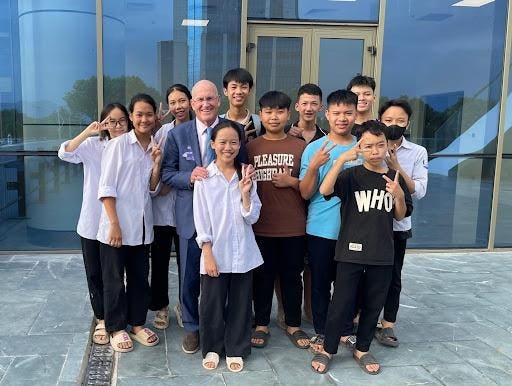A recent trip to Vietnam underscored how this fascinating Southeast Asia region is adeptly maneuvering the rift between the United States and China to fuel its own economic rise.
I was in Hanoi for the Vietnam Venture Summit 2023, an event organized by the country’s Ministry of Planning and Investment and Golden Gate
GT
The event featured hundreds of local startup entrepreneurs eager to meet with foreign and regional venture capital firms. The investor “speed dating” portion was so popular that the organizers needed to add a second session.
The participants were overwhelmingly young, optimistic, and well-educated. The companies on offer spanned fields including artificial intelligence, gene technology, renewables, education technology, and fintech. The atmosphere reminded me of China two decades ago when foreign capital and expertise were welcome, and the growth potential seemed unbounded.
‘Bamboo Diplomacy’ Pays Off
Vietnam has emerged as one of the rare winners during recent years of de-globalization thanks to its thoughtful policy of “bamboo diplomacy”. The policy has enabled it to upgrade relations with the West while maintaining positive ties with its largest trading partner, China. Bamboo diplomacy is enshrined in Vietnam’s “Four No’s”: no military alliances, no picking sides in conflicts, no foreign military bases, and no use of force in international relations. Officials are open to doing business with anyone as long as they aren’t dragged into quarrels.
The nation has invested heavily in education and infrastructure while offering industrial wages about half as high as those in China. Vietnam’s government has adopted a series of policies to remove barriers to foreign investment. And it still has reserves of untapped rural laborers to draw on, with urbanization currently at 38% compared to 65% in China.
Vietnam has negotiated free trade agreements with 15 nations, enabling it to plug into regional supply chains without incurring tariffs.
These factors have made Vietnam an ideal locale for multinationals seeking to de-risk their supply chains with a “China Plus one” manufacturing strategy.
Today, Samsung employs 200,000 people in Vietnam and has invested $17 billion in facilities to crank out smartphones and other devices. Foxconn Technology assembles Apple’s
AAPL
NDAQ
During Biden’s trip, Nvidia (NASDAQ:NVDA) and Microsoft
MSFT
SNPS
MRVL
Foreign direct investment is set to reach a new record in this year, rising by 54% to $15.3 billion in the first ten months of 2023, Investment Monitor reported. This occurred even as China reported negative FDI in the third quarter for the first time since opening up its economy after the Covid-19 pandemic, Bloomberg noted.
Preparing For The Global Stage
While Vietnam has become a magnet for multinational manufacturing, achieving prosperity will require attracting significant foreign capital to back its domestic companies. However, the country’s immature financial markets have posed a considerable obstacle. Put simply, foreign financial institutions are reluctant to put money to work without clear paths to exit.
Vietnam’s domestic stock exchanges in Ho Chi Minh City and Hanoi are categorized as frontier markets by FTSE and MSCI
MSCI
Until recently, it was unclear if a Vietnamese company could launch an IPO overseas without running afoul of its domestic laws. The recent listing of Vietnam’s electric vehicle manufacturer, VinFast (NASDAQ:VFS), on NASDAQ through a SPAC merger has opened the door for more of the country’s leading companies to step out on a global stage.
One likely candidate, VNG, is Vietnam’s leading video game company and owns the ubiquitous Zalo messaging app, which is used by 75% of the population. VNG had planned a $150 million U.S. IPO this year but reportedly decided to delay until 2024 in hopes of more favorable market conditions. At the conference, VNG’s CEO, Le Hong Minh, described the company’s evolution from distributing PC games and posters to internet cafes by motorcycle in 2005 to developing AI large language models customized for Vietnam today.
Other players said to be weighing future overseas IPOs include Vietnam’s largest retail company, The CrownX, valued at $8.2 billion in its last private funding round, and Momo, a Vietnamese payment app with 30 million users, backed by Warburg Pincus.
If Vietnam can generate a few high-profile exits, that could spur more sizable private investments.
Tapping Into Vietnam’s Talent
Vietnam’s aspirations reach beyond being the factory floor annex to China. It seeks to become a technologically advanced and sustainable economy and achieve upper- middle-income status following the path laid out by Asian leaders such as Korea and Singapore in decades past.
Vietnam’s legislature recently set a target for GDP growth of 6% to 6.5% in 2024, and its digital economy is expected to grow at 20% a year, reaching $45 billion in 2025, according to a recent report by Bain and Google
GOOG
Meeting those goals will require tapping into the abundant dreams and drive of young entrepreneurs like those I met at the Venture Summit. Central planning can effectively build infrastructure and provide worker training. However, it is unlikely to spawn innovative companies that will put Vietnam on the map with global investors.
Vietnam’s next generation appears eager to learn from the outside, take risks, and start businesses that haven’t yet been conceived. The entrepreneurs told me that they felt that their moment had arrived. After spending a few days with them, I was convinced that Vietnam’s economic rise was just beginning.
Read the full article here


